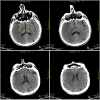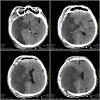Malignant Middle Cerebral Artery Infarction Secondary to Traumatic Bilateral Internal Carotid Artery Dissection. A Case Report
- PMID: 29967852
- PMCID: PMC5953249
- DOI: 10.1515/jccm-2016-0021
Malignant Middle Cerebral Artery Infarction Secondary to Traumatic Bilateral Internal Carotid Artery Dissection. A Case Report
Abstract
Traumatic bilateral dissection of the carotid arteries is a rare condition with potentially life-threatening complications. The case of a 57-year-old male patient with acute onset left sided hemiparesis, twelve hours after a blunt head injury, caused by a horse kick, is reported. A cerebral CT scan revealed right middle cerebral artery (MCA) territory infarction. Based on Duplex ultrasound and Angio CT scan findings, a diagnosis of bilateral ICA dissection was established. Despite antithrombotic treatment, the patient presented with a progressive worsening of his neurological status. The control CT scan evidenced malignant right MCA territory infarction that required decompressive craniotomy. The patient was discharged with significant neurological deficits. Together with this case, the aetiologies, clinical manifestations, diagnostic and therapeutical options and outcome of carotid artery dissection are discussed.
Keywords: carotid artery dissection; malignant infarction; traumatic.
Conflict of interest statement
Conflict of interest: None declared
Figures





Similar articles
-
Delayed dissection of the internal carotid artery following major facial trauma: a case report.Crit Care Resusc. 1999 Sep;1(3):285-7. Crit Care Resusc. 1999. PMID: 16603017
-
Rare case of bilateral traumatic internal carotid artery dissection.BMJ Case Rep. 2016 Sep 20;2016:bcr2016217262. doi: 10.1136/bcr-2016-217262. BMJ Case Rep. 2016. PMID: 27651410 Free PMC article.
-
[A case of adult moyamoya disease showing fulminant clinical course associated with progression from unilateral to bilateral involvement].No Shinkei Geka. 1997 Jan;25(1):79-84. No Shinkei Geka. 1997. PMID: 8990473 Review. Japanese.
-
Spontaneous intracranial internal carotid artery dissection treated by intra-arterial thrombolysis and superficial temporal artery-middle cerebral artery anastomosis in the acute stage--case report--.Neurol Med Chir (Tokyo). 2005 Mar;45(3):148-51. doi: 10.2176/nmc.45.148. Neurol Med Chir (Tokyo). 2005. PMID: 15782006
-
[Spontaneous intracranial internal carotid artery dissection: 6 case reports and a review of 39 cases in the literature].Rinsho Shinkeigaku. 2003 Jun;43(6):313-21. Rinsho Shinkeigaku. 2003. PMID: 14503348 Review. Japanese.
Cited by
-
Prevalence and Clinical Characteristics of Subclavian Steal Phenomenon/Syndrome in Patients with Acute Ischemic Stroke.J Clin Med. 2021 Nov 10;10(22):5237. doi: 10.3390/jcm10225237. J Clin Med. 2021. PMID: 34830519 Free PMC article.
-
Stroke Secondary to Traumatic Carotid Artery Injury - A Case Report.J Crit Care Med (Targu Mures). 2018 Feb 9;4(1):23-28. doi: 10.1515/jccm-2018-0003. eCollection 2018 Jan. J Crit Care Med (Targu Mures). 2018. PMID: 29967897 Free PMC article.
-
Giant cell arteritis with rare manifestations of stroke and internal carotid artery dissection: A case study.Clin Case Rep. 2022 Mar 20;10(3):e05597. doi: 10.1002/ccr3.5597. eCollection 2022 Mar. Clin Case Rep. 2022. PMID: 35340656 Free PMC article.
-
Bilateral Blunt Traumatic Dissections of the Extracranial Internal Carotid Artery: A Case Report and Literature Review.Cureus. 2024 Feb 5;16(2):e53630. doi: 10.7759/cureus.53630. eCollection 2024 Feb. Cureus. 2024. PMID: 38449976 Free PMC article.
-
Diagnostic and prognostic computed tomography imaging markers in basilar artery occlusion (Review).Exp Ther Med. 2021 Sep;22(3):954. doi: 10.3892/etm.2021.10386. Epub 2021 Jul 6. Exp Ther Med. 2021. PMID: 34335896 Free PMC article. Review.
References
-
- Crönlein M, Sandmann GH, Beirer M, Wunderlich S, Biberthaler P, Huber-Wagner S.. Traumatic bilateral carotid artery dissection following severe blunt trauma: a case report on the difficulties in diagnosis and therapy of an often overlooked life-threatening injury. Eur J Med Res. 2015;20:62. - PMC - PubMed
-
- Samra NS, Ravi AK, Johnson LW, Williams M.. Traumatic bilateral carotid artery dissection. J La State Med Soc. 2011(163):26–8. - PubMed
-
- Arnold M, Kappeler L, Georgiadis D. et al. Gender differences in spontaneous cervical artery dissection. Neurology. 2006(67):1050–2. - PubMed
-
- Liebeskind DS, Saver J.. Spontaneous cerebral and cervical artery dissection: clinical features and diagnosis. UpToDate. 2016; cerebrovascular diseases. http://www.uptodate.com/contents/spontaneous-cerebral-and-cervical-arter...
-
- Chaves C, Estol C, Esnaola MM. et al. Spontaneous intracranial internal carotid artery dissection: report of 10 patients. Arch Neurol. 2002(59):977–81. - PubMed
LinkOut - more resources
Full Text Sources
Other Literature Sources
Miscellaneous
